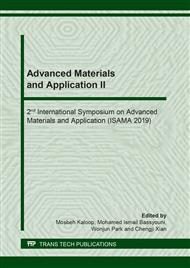p.109
p.116
p.122
p.128
p.134
p.141
p.146
p.155
p.161
"Green" Bleaching Process of Sugar Palm (Arenga pinnata) Flour by Using Sodium Salt and Ozone Technology
Abstract:
Sugar palm (Arenga pinnata) is one of important commodities in Indonesia. One method that has been used to whiten sugar palm flour is by bleaching process using chlorine (Ca(ClO)2). Unfortunately, the use of chlorine as a whitening agent is considered harmful to health and the environment. One of alternative methods that can be considered as “Green” bleaching process for sugar palm whitening is ozone technology. The effects of ozonation process and different concentrations of NaCl and Na2SO4 added in the ozonation process to the whiteness (i.e. L* and b* scale) and protein content of sugar palm flour were investigated. Suspension of sugar palm flour-water was contacted with ozone gas at rate of 325 mg/hour. The duration of ozonation process was varied for 30, 60, 90, 120, 150, and 180 minutes. The initial concentration or ratio of sugar palm and water was also varied, i.e. 1:2 (wt/wt); 1:3 (wt/wt); and 1:4 (wt/wt). To determine the effect of adding sodium salt; NaCl and Na2SO4 were added at different concentrations of 5, 10, and 15 g/L each. The test results showed that pH of the flour and b* value decreased, while L* value of sugar palm flour increased with the increasing ozonation time. The results also showed that the most significant increase of L* value was at the sample ratio (sugar palm:water) of 1:3 (wt/wt) and 30 minutes of ozonation time. The optimal NaCl addition concentration was 10 g/L with 150 minutes of ozonation time. Whereas, the optimal Na2SO4 addition concentration was 15 g/L with 150 minutes of ozonation time. The addition of Na2SO4 resulted in an increase of L* value greater than the NaCl. The protein content of sugar palm flour also decreased along with the increase of flour whiteness. A maximum decrease in protein content of 57% occurred in flour samples with initial concentration or ratio of 1:3 (wt/wt) and ozonation time of 30 minutes.
Info:
Periodical:
Pages:
134-140
Citation:
Online since:
June 2019
Keywords:
Price:
Сopyright:
© 2019 Trans Tech Publications Ltd. All Rights Reserved
Share:
Citation:


